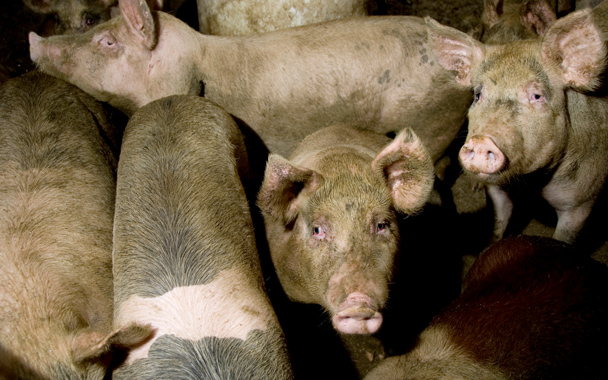L ate last month the Food and Drug Administration (FDA) closed the comment period on guidelines that will pave the way for agribusiness to introduce genetically engineered (GE) animals into the nation’s food supply. According the Toronto Star, the so-called Enviropig, developed by Cecil Forsberg, a researcher at the University of Guelph in Ontario, may be one of the first bioengineered critters to stride from the laboratory to the barnyard.
Although Enviropigs look no different that the Yorkshires from which they were derived, they carry a mouse gene that makes them produce feces that are less environmentally damaging than those excreted by a normal pig. This is a potential boon for factory hog producers, who face the perennial problem of dealing with hundreds of tons of waste.
Forsberg says that the mouse DNA allows his brave new oinkers’ digestive systems to produce an enzyme that processes plant phosphorous more efficiently, leaving 60 percent less of the chemical (which produces toxic algal blooms in waterways) in their waste. The newspaper states that he has already submitted “reams of research” to the FDA. His chemical analysis shows that the composition of meat from an Enviropig is the same as that of ordinary pork, and none of the mouse genetic material is found in cuts such as the ham, chop, loin, or shoulder.
Under orders from the outgoing administration, the FDA is hellbent on pushing GE foods onto our dinner plates, despite recent studies that have raised serious concerns about potential harmful effects from eating them, and warnings from groups such as the Center for Food Safety about the total lack of long-term information on GE food in the diets of humans or animals.
Forsberg is more worried about consumer acceptance than bureaucratic approval. “The big question used to be ‘Can we do it?’” he told the newspaper. “Now, it is ‘If we produce it, will they eat it?’”
The FDA is doing its best to eliminate that problem. The proposed guidelines stipulate that retailers will not be required to label GE meat. So the answer to Forsberg’s question is “They will eat it if they don’t know what it is.”
GE mouse chops, anyone?
The Right Way to Farm Fish
Australis Aquaculture achieved seafood’s trifecta of sustainability this week. The Australian company earned a “Best Choice” ranking in the Blue Ocean Institute’s Guide to Ocean Friendly Seafood for its farmed barramundi, a white-fleshed Australian species that it raises in Massachusetts.
The company had already earned the same status in the Monterey Bay Aquarium’s Seafood Watch guide and Environmental Defense’s Seafood Selector.
“Australis’ farming operation in the U. S. appears to have minimal impact on the surrounding environment, efficient conversion of ‘food to fish’ and an innovative closed re-circulating system that recycles water, prevents fish escapes and disease, and reduces waste. Plus, chemicals like antibiotics and hormones are never used,” Blue Ocean’s Alan Duckworth said in a release.
I wonder if the news reached the folks over at the USDA’s National Organic Standards Board? Last week, they caved in to industry pressure by approving regulations that would allow open-water salmon farms to be certified as “USDA Organic.”
Farmed salmon score a reverse trifecta, ranking at the very bottom of sustainability lists and possessing none of the positive attributes Duckworth cites. Someone needs to point out to the USDA that there are good ways to farm fish. Open-water salmon operations are not one of them.




 Pinterest
Pinterest


